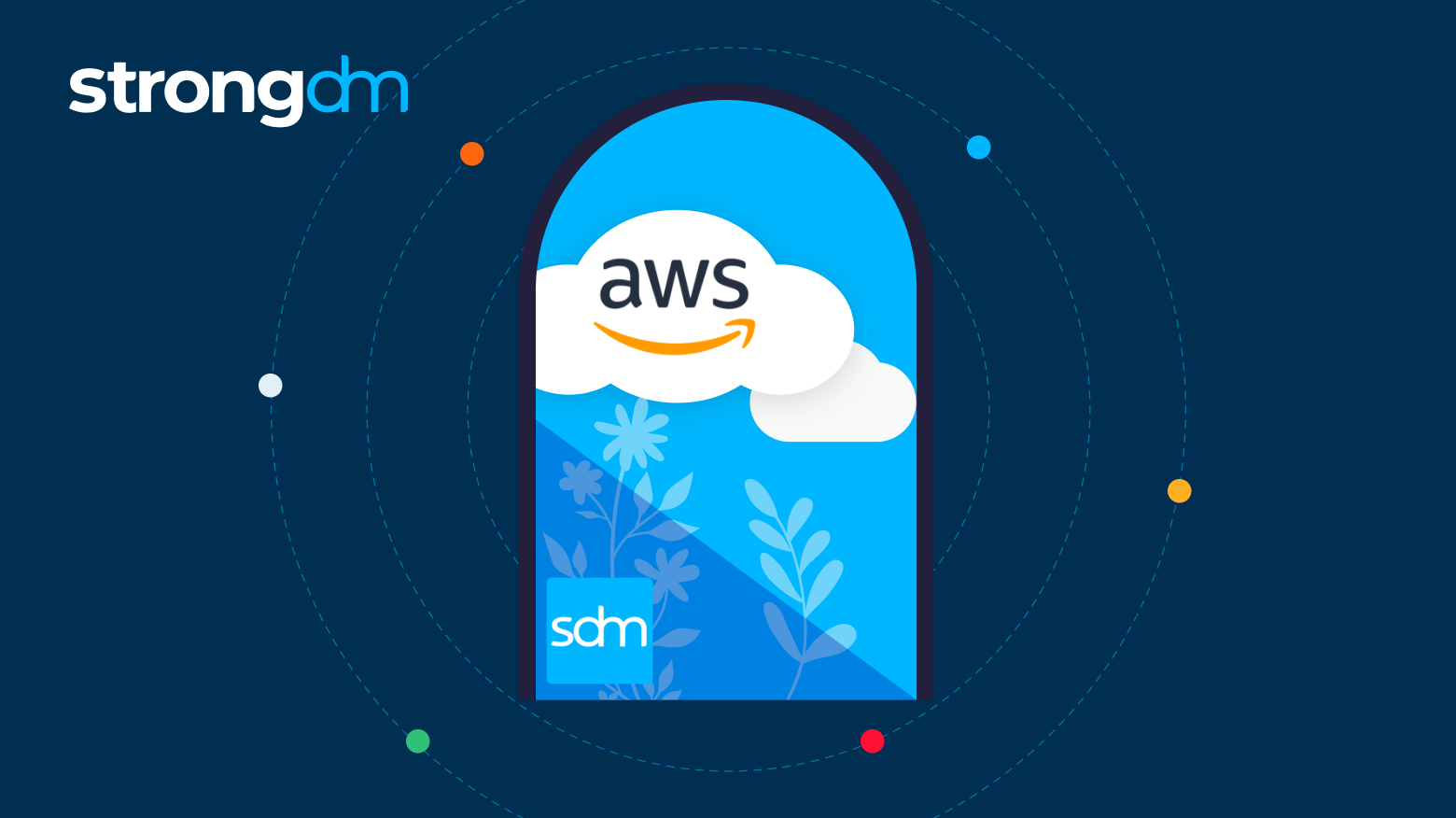

Written by
Schuyler BrownLast updated on:
January 22, 2025Reading time:
Contents
Built for Security. Loved by Devs.
- Free Trial — No Credit Card Needed
- Full Access to All Features
- Trusted by the Fortune 100, early startups, and everyone in between
Want a secure and compliant AWS environment? Then you need to audit access. Keeping tabs on who has accessed what—as well as the whens, wheres, and whys—helps you spot suspicious activities and address them promptly. Without this kind of access visibility, your sensitive data could be exposed to malicious actors, putting you at risk of data breaches and subsequent regulatory nightmares or service interruptions.
A game-changing tool like StrongDM makes auditing access in AWS a breeze. It streamlines the entire process through Dynamic Access Management (DAM), a cloud-native privileged access management tool, that tracks every user activity and query. StrongDM centralizes user visibility and access control to ensure that only authorized individuals and systems can navigate your AWS environment.
Why You Need to Audit Access in AWS
Any unauthorized access or security breach in your AWS account can spell disaster for your organization. A breach can lead to financial loss, reputational damage, and legal liabilities.
This could be through data theft, service disruption, and a compromise of your entire infrastructure. There’s also the possibility of customer information being used for fraudulent purposes or your systems grinding to a halt—which was the fate of 71% of organizations in 2022.
In addition to these risks, regulators have tightened their grip on access auditing through stringent compliance requirements and industry standards. Regulations like GDPR, HIPAA, and PCI-DSS demand strict controls over data access and protection. And frameworks like ISO 27001 outline specific guidelines for auditing access.
These mandates require organizations to implement secure access controls, maintain audit trails, monitor user activities, and prove compliance—which bolsters data security and instills trust among customers and other stakeholders.
Challenges of Auditing Access in AWS
Managing access across multiple AWS accounts, regions, and services can be daunting.
Coordinating user permissions, policies, and credentials across diverse environments demands careful planning and robust Identity and Access Management (IAM) strategies. Plus, you need to maintain the segregation of duties, centralized visibility, and secure cross-account access.
Tracking and monitoring user activities in a dynamic cloud environment adds an additional layer of complexity.
With user permissions changing frequently and your cloud infrastructure constantly scaling up or down, keeping track of users and their actions is difficult. The distributed nature of cloud systems and the sheer volume of data generated also make it difficult to capture and analyze user activities in real time.
Achieving comprehensive visibility requires robust logging, real-time monitoring, and intelligent analytics tools to capture and analyze user actions.
However, auditing access in AWS can be manual and time-consuming. Periodic audits of security configuration require manual reviews of IAM users, roles, groups, and policies to ensure users and software don't have more permissions than they need.
This challenge is even more pronounced when hiring AWS developers and expanding your team. Each new hire requires precise access controls to prevent unnecessary permissions while ensuring they have the right level of access to develop, test, and deploy applications securely. Without a streamlined access management system, onboarding new developers can quickly become a security risk.
Simplify Audit Access in AWS with StrongDM
StrongDM simplifies access management and auditing in AWS through a centralized platform that integrates seamlessly with AWS services—allowing you to manage user access across multiple accounts, regions, and services from a single interface.
With StrongDM, you can easily grant users just the right level of permissions for their tasks. You can also enforce the principle of least privilege, track user activities in real time, and promptly respond to potential security risks.
StrongDM includes many features that improve how you audit access in AWS:
- StrongDM’s Advanced Insights reports further simplify auditing access by providing deep visibility into user activities and access patterns with comprehensive analytics. This helps you analyze access trends and identify anomalies. Additionally, the reports facilitate compliance efforts by providing comprehensive audit trails and documentation for regulatory requirements.
- The robust logging and monitoring capabilities of StrongDM help you capture detailed logs of user activities—including login attempts, executed queries, and administrative actions. Moreover, you can leverage StrongDM’s real-time monitoring feature for alerts on suspicious or unauthorized activities. You can set up alerts for specific events to proactively respond to potential security threats.
- In addition, StrongDM provides real-time visibility into user activities and access patterns, capturing and recording every user action instantaneously. With StrongDM's intuitive interface, you can easily review these activities and gain insights into who accessed what and when. By tracking access patterns, you can identify trends, analyze usage, and make informed decisions about access controls and resource allocation.
- The granular audit logs and reports track and document all access controls and activities. They provide detailed insights into access patterns, user behavior, and resource usage—serving as an invaluable audit trail and enabling you to demonstrate compliance with industry regulations.
Implementing StrongDM for Access Auditing in AWS
Setting up StrongDM in your AWS environment is a straightforward process:
- Install the StrongDM agent on your desired EC2 instances to establish a secure connection.
- Create IAM roles granting StrongDM permissions for access management.
- Configure StrongDM's access policies, specifying resource accessibility for different users.
Once configured, StrongDM takes care of access management, granting users secure, audited access to your AWS resources.
To configure StrongDM for AWS IAM integration:
- Navigate to the StrongDM Admin UI and go to the "Roles" tab.
- Click on "Add Role" and select "AWS Role" as the role type.
- Provide a name for the role and attach the desired IAM policy to it.
- Assign the role to the appropriate StrongDM users or groups.
After completing these steps, when users authenticate with their AWS credentials, StrongDM will automatically map their IAM roles to their StrongDM roles. This ensures that users inherit the correct permissions in StrongDM based on their AWS IAM roles, simplifying administration and maintaining a secure access control environment.
Through StrongDM's intuitive interface, you can define granular access policies tailored to your specific needs. You can also assign permissions at the individual level or group users into logical units for easier management. Consequently, you have full control over who can access which resources by granting privileges at the database, server, or application level.
Best Practices for Access Auditing in AWS with StrongDM
When configuring StrongDM policies and rules, consider the following recommendations:
- Start with the principle of least privilege: Assign users the minimum necessary permissions to perform their tasks. This reduces the risk of unauthorized access.
- Organize users into logical groups: Group users based on their roles or responsibilities to make managing access permissions easier.
- Regularly review and update policies: Continuously assess and refine your access policies to align with changing requirements and user roles.
- Leverage tags and labels: Use tags to categorize resources and apply policies consistently, while ensuring accurate access controls.
- Enable multi-factor authentication (MFA): Strengthen security by requiring additional authentication factors for user access.
- Monitor and audit user activities: Use StrongDM's auditing capabilities to track and review user actions in order to detect suspicious behaviors.
In addition to following these recommendations, you may want to review and analyze access logs to detect potential security threats. Start by establishing a baseline of normal activities to identify deviations that could indicate anomalies. Then look for unusual login patterns, repeated failed login attempts, and access from unfamiliar IP addresses.
While doing so, pay close attention to privilege escalation attempts or unauthorized access attempts to critical resources. Correlating access logs with other security event data and implementing real-time monitoring and alerts can help you identify and promptly respond to suspicious activities.
These audit findings reveal vulnerabilities, access gaps, and outdated permissions that may pose risks.
By regularly reviewing and updating access controls based on them, you can identify areas that require attention and then adjust access controls accordingly. This could mean revoking unnecessary privileges, updating roles, and ensuring the principle of least privilege.
How Coveo Simplified Auditing Access in AWS with StrongDM — A Case Study
Coveo, a market-leading AI-powered relevance platform, began as an on-premises solution and evolved into a multi-tenant service with separate accounts for development, production, and HIPAA compliance. As the company expanded to over 20 databases per environment per region, managing access rights became a challenge.
Coveo needed a better alternative to handling and updating 100 usernames and passwords per employee.
After deploying StrongDM to centralize the employee login process and access management, Coveo’s administrators and developers gained the ability to grant just-in-time, least-privilege access from a single control plane.
With StrongDM, employees received one credential that granted them access to all resources, irrespective of location or protocol. This streamlined the onboarding process and eliminated the need for provisioning multiple credentials for each database.
StrongDM also offered centralized and comprehensive audit logs, simplifying compliance audits and providing the Coveo team with complete visibility across their entire infrastructure. This made it easier for Coveo to demonstrate compliance, and in the event of a security breach, the audit trail would help them identify the cause.
Moreover, StrongDM reduced administrative work for DevOps teams by automating permission assignments through integration with tools like Terraform and the StrongDM API. This allowed the team to focus on critical initiatives and projects instead of managing lost password requests.
Coveo R&D Security Defence Team Lead Jean-Phillipe Lachance describes how important StrongDM has been to their development:
“I need to work on intrusion detection, anomaly detection, AWS account management, hardening those databases, and hardening our AWS resources. Even if we had more developers, if we did not have StrongDM, we would need to just say no to new projects. That would greatly impact our ability to grow.” (source)
Audit Access with StrongDM
Auditing access ensures the security and compliance of your AWS environment. But managing access across multiple AWS accounts, regions, and services demands careful planning and robust IAM strategies. And a dynamic cloud environment adds an additional layer of complexity.
Successfully navigating these challenges requires careful orchestration, automation, and adherence to best practices. But auditing access in AWS is, by default, a manual and time-consuming process.
This is where StrongDM comes in.
StrongDM gives you all the additional tools you need to streamline audits and fulfill compliance obligations.
Visit StrongDM in the AWS Marketplace to strengthen your organization’s access management and auditing practices in AWS.
See StrongDM in action, book a demo.
Next Steps
StrongDM unifies access management across databases, servers, clusters, and more—for IT, security, and DevOps teams.
- Learn how StrongDM works
- Book a personalized demo
- Start your free StrongDM trial


About the Author
Schuyler Brown, Chairman of the Board, began working with startups as one of the first employees at Cross Commerce Media. Since then, he has worked at the venture capital firms DFJ Gotham and High Peaks Venture Partners. He is also the host of Founders@Fail and author of Inc.com's "Failing Forward" column, where he interviews veteran entrepreneurs about the bumps, bruises, and reality of life in the startup trenches. His leadership philosophy: be humble enough to realize you don’t know everything and curious enough to want to learn more. He holds a B.A. and M.B.A. from Columbia University. To contact Schuyler, visit him on LinkedIn.
You May Also Like




